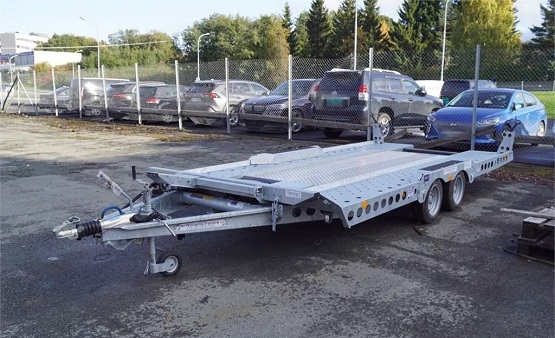
Transporting Farm and Warehouse Equipment With a Car Trailer
Owning and managing a property, whether residential or commercial, oftentimes entails moving furniture and equipment around. These types of operations are important for optimal use of the assets at your disposal. Not only that, sometimes you need to move your machinery or equipment for regular maintenance or repairs. Warehouse and landscaping equipment can be rented or bought and then returned or sold. Each of these scenarios involves transporting the equipment across a formidable distance.

Forklifts, golf carts and lawnmowers move on their own within a predetermined area. However, they can not use roads to cover the distance needed to get from point A to point B. If your fleet consists of a large number of small vehicles your best option is to hire a truck to transport them. But if you only need to transport a single piece of machinery you can use a car trailer, provided you hold all of the necessary permits.
Car Trailer
First things first, before you even consider such a feat you need to rent or buy a heavy-duty car trailer. You can easily find one online that’s made in Australia, so you can rest assured it will be able to withstand the harsh Australian weather and remote road conditions. The trailer you choose should be made from high-quality materials to handle the weight of the cargo. That being said, one of the best choices would be a galvanised trailer with low sides. The tie points have to feature really tough hardware for you to be able to safely transport equipment and machinery around. This kind of trailer usually has a checker plate floor. However, you can go for any other option as long as the floor is durable and able to withstand the load.
Several calculations are necessary to ensure safe transport. The most important one is the aggregate trailer mass or ATM. Under no circumstances should your load exceed the ATM, because this will jeopardize your road safety. Plus, it will unnecessarily increase the risks for everyone else using the road. The ATM is the total weight of the trailer and its cargo before they are attached to a vehicle. It represents the upper limit for the carrying capacity of your trailer. Most trailer models have an aggregate trailer mass of 2000kg, but you can also find variations able to carry heavier loads (2500kg and up to 3000kg).
The trailer measurements are approximately 3900mm x 1980mm, because this is what road safety regulations allow. Some of the distinctive features of a quality trailer are disc brakes, magnetic trailer plugs and full chassis.

Preparation of the Machine
This process involves a series of fairly straightforward steps, but you still need to be very careful if you want to make sure you do it properly. If you don’t know the exact weight of your forklift (or a lawnmower) go the extra mile and measure it. You have to be sure it’s within the capacity of the trailer. The same goes for length.
Before proceeding, inspect the vehicle for faults and disengage the fuel supply. The procedures are different for propane-powered forklifts, diesel tanks and electric battery banks, but the goal is the same. You aim to decrease the likelihood of electrical arcing or fire mid-transit.
Prepare wood blocks and wheel chocks to prevent the equipment from rolling. Take other precautions to prevent tipping if applicable. Most machines are loaded in reverse. If there are protrusions at the front (like the forks on a forklift) lower them and tilt them forward. Once on the trailer, the machine needs to be secured by chains at several anchor points. Bigger trailers have a come-along and hooks, but if your trailer doesn’t have any, make sure there is appropriate rigging to secure the lawnmower in place. You should be able to accomplish all this with your regular automotive tools, but if you are not experienced and don’t feel up to the task, consult a rigger.

The Towing Vehicle
There are strict road regulations about the type of vehicle you can use to tow any trailer in Australia. In general, an SUV and 4WD can be used to tow a trailer loaded with small farming or warehouse equipment. You should pay attention to the Gross Vehicle Mass (GVM). The GVM refers to the maximum your vehicle can weigh when fully loaded. On top of that, you need to be within the capacity of the towing equipment fitted to the vehicle, and the ATM I mentioned above. Having a good set of rearview mirrors is very important for maintaining control during transit. If you intend to do this often you should also consider fitting your vehicle with towing mirrors.
Safety First
Putting together a setup of a towing trailer loaded with light equipment and a towing vehicle might seem like a simple operation, but you should never underestimate their complexity. Hire a professional if you are not confident in the level of preparation you need to be able to put into the project. It’s always better to do the extra work to ensure road safety than to risk damage to the equipment or injure yourself and other pedestrians. Practice caution at all steps.


